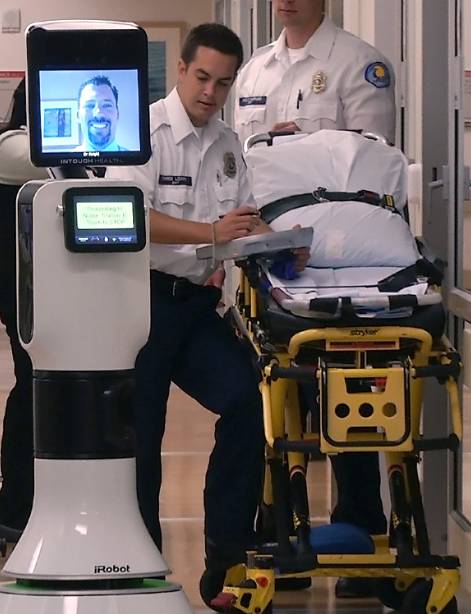Meet VIDA, the ICU’s Newest Robot
 It’s here. The Rosie the Robot of the hospital.
It’s here. The Rosie the Robot of the hospital.
This week InTouch Health and iRobot will unveil the Remote Presence Virtual + Independent Telemedicine Assistant (RP-VITA), a robot that will wander the halls and participate in team-based rounds in the intensive care unit.
It acts and looks just like you might think. VITA is about five foot four, has a computer for a head, can look up and down and can scoot autonomously around a hospital.
VITA is the brainchild of InTouch, a company that specializes in acute care telemedicine, and iRobot, a 20-year-old company that has put more than 4,500 explosive device-removing robots in areas of conflict overseas.
VITA isn’t exactly an artificially intelligent robot like IBM’s Watson (or Jetson’s Rosie), rather it’s more of an avatar for doctors to beam into from afar. VITA’s head is a monitor that displays video of a remote doctor. Its main purpose is to provide a way for the correct doctor to be present, especially in emergency or critical situations.
“Bad things happen to patients in any time of day or night, and it’s very difficult to get the right expert there at the right time to take care of them,” InTouch Health’s CEO Yulan Wang said.
InTouch’s focus is using telemedicine for severe and unexpected medical events that land patients in the emergency department or in the ICU. The company’s technology is in about 600 hospitals.
ICU and ED telemedicine aims to bridge communication gaps between all of the clinicians involved in one patient’s care.
“In a team based around a patient, you might have a patient’s core physicians, you might have an intensivist, you might have someone like a cardiologist because it’s a heart-related problem. You might have a pharmacist, you might have a nutritionist. These people all need to coordinate on that patient at the same time.” Wang said. “The issue is that they’re not all standing by the patient at the same time.”
Hoag Memorial Hospital Presbyterian, Ronald Reagan UCLA Medical Center and the Children’s Hospital of Orange County all participated in clinical validations for VITA as part of the Food and Drug Administration clearance process.
VITA will debut at InTouch Health’s Annual Clinical Innovations Forum, which will take place from July 26 – 28 in Santa Barbara, CA. Wang said the robot hasn’t been deployed yet because the company is still in the final stages of finishing the system. When it’s ready to go, InTouch expects to lease VITA for about $4,000 to $6,000 per month.
In addition to remote telemedicine capabilities, VITA’s other features include Obstacle Detection Obstacle Avoidance technology, real-time access to patient clinical data, and an iPad user interface. VITA’s autonomous navigation capability is being submitted to the FDA for clearance. It’s meant to allow a remote clinician or bedside nurse to send the robot to a target destination with the click of a button.
Wang said that VITA targets two huge obstacles that hospitals face ― enabling care from the right clinician when the patient needs it, and handing off patient information to other staff members for better coordinated care.
“My belief is that if you can do just those two things effectively, you’ve really brought the health care system up quite dramatically with regard to improving quality, access and lowering cost,” Wang said.


 Idea for a guest post? Get in
Idea for a guest post? Get in